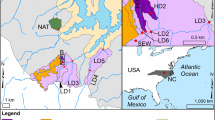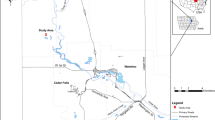Abstract
Grand Lake St Marys (GLSM) is one of the most hypereutrophic lakes in North America and was officially declared distressed in 2011 as a result of excess nutrient runoff from primarily agricultural cropland and livestock facilities. Concurrently, the watershed has also struggled with excessive fecal coliform loads most evident by the routine public warnings regarding colony counts in GLSM. This study evaluated in stream trends and the potential for reconstructed wetlands along Coldwater Creek to reduce coliforms in the watershed. Non-Escherichia coli coliforms in Coldwater Creek showed a seasonal pattern, with a winter low coincident with the distressed watershed winter ban on manure application. E. coli coliform loads did not show the same seasonal pattern, but may have been offset by wildlife fecal inputs. When water flowed into the wetland, concentrations of total coliforms were reduced by 40%, mainly driven by residence time. When the wetland was a net sink, it reduced E. coli by 71% and non-E. coli coliforms by 51%. Unfortunately, it also served as a source for total coliforms 4 weeks of the year. Treating all tributaries into GLSM would require the equivalent of ~ 20× the current wetland area in the watershed.




Similar content being viewed by others
Data availability
All data are available in the appendix.
Code availability
Not applicable.
References
Akaike, H., 1974. A new look at the statistical model identification. IEEE Transactions on Automatic Control 19: 716–723.
Baker, D. B., R. Confesor, D. E. Ewing, L. T. Johnson, J. W. Kramer & B. J. Merryeld, 2014. Phosphorus loading to Lake Erie from the Maumee, Sandusky, and Cuyahoga Rivers: the importance of bioavailability. Journal of Great Lakes Research 40: 502–517.
Beutel, M. W., V. Whritenour & E. Brouillard, 2013. Fecal coliform removal in a lightly loaded surface-flow constructed treatment wetland polishing agricultural runoff. Water Science and Technology 68(4): 909–915.
Birch, G., C. Matthai, M. Fazeli & J. Suh, 2004. Efficiency of a constructed wetland in removing contaminants from stormwater. Wetlands 24(2): 459–466.
Buij, R., T. Melman, M. Loonen & A. Fox, 2017. Balancing ecosystem function, services and disservices resulting from expanding goose populations. Ambio 46: 301–318.
Carberry, B., T. A. Langen & M. R. Twiss, 2021. Surface water quality differs between functionally similar restored and natural wetlands of the Saint Lawrence River Valley in New York. Land 10: 676.
Dallas, S., B. Scheffe & G. Ho, 2004. Reedbeds for greywater treatment—case study in Santa Elena-Monteverde, Costa Rica. Central America. Ecological Engineering 23(1): 55–61.
Dendup, T., D. Tshering, P. Mafchan, I. M. Ghalley, P. Wangmo & T. Sunwar, 2021. Efficiency of natural wetland in wastewater treatment: A case study of Singye Karm Nature Reserve wetland at Sherubtse College, Kanglung, Bhutan. Sherub Doenme 14: 5–21.
Díaz, F., T. O’Geen & A. Dahlgren, 2010. Efficacy of constructed wetlands for removal of bacterial contamination from agricultural return flows. Agricultural Water Management 97(11): 1813–1821.
Frey, S. K., E. Topp, B. R. Ball, M. Edwards, N. Gottschall, M. Sunohara, E. Zoski & D. R. Lapen, 2013. Tile drainage management influences on surface-water and groundwater quality following liquid manure application. Journal of Environmental Quality 42(3): 881–892.
Fries, J. S., G. W. Characklis & R. T. Noble, 2006. Attachment of fecal indicator bacteria to particles in the Neuse River Estuary. NC. Journal of Environmental Engineering 132(10): 1338–1345.
Garcia-Armisen, T. & P. Servais, 2009. Partitioning and fate of particle-associated E. coli in river waters. Water Environment Research 81: 21–28.
Grand Lake/Wabash Watershed Alliance (GLWWA), 2008. Grand Lake St. Marys/Wabash River watershed action plan: A partnership between Soil and Water Conservation Districts. Darke, Auglaize, and Mercer Counties and the city of Celina. https://water.ohiodnr.gov/portals/soilwater/downloads/wap/Wabash.pdf.
Green, M., P. Griffin, J. Seabridge & D. Dhobie, 1997. Removal of bacteria in subsurface flow wetlands. Water Science and Technology 35(5): 109–116.
Hathaway, J. M., W. F. Hunt & S. Jadlocki, 2009. Indicator bacteria removal in storm-water best management practices in Charlotte, North Carolina. Journal of Environmental Engineering 135(12): 1275–1285.
Hoorman, J., T. Hone, T. Sudman, T. Dirksen, T. Iles & R. Islam, 2008. Agricultural impacts on lake and stream quality in Grand Lake St. Marys, Western Ohio. Water Air Soil Pollution 193: 309–322.
Humphrey, C., N. Chaplinski, M. O’Driscoll, T. Kelley & S. Richards, 2014. Nutrient and Escherichia coli attenuation in a constructed stormwater wetland in the North Carolina Coastal Plain. Environment and Natural Resources Research 4(3): 12–22.
Hsu, T. T. D., W. J. Mitsch, J. F. Martin & J. Lee, 2017. Towards sustainable protection of public health: the role of an urban wetland as a frontline safeguard of pathogen and antibiotic resistance spread. Ecological Engineering 108: 547–555.
Kast, J, 2018. Manure management in the Maumee River Watershed and watershed modeling to assess impacts on Lake Erie’s water quality. Master of Science Thesis – The Ohio State University.
Jacquemin, S. J. & M. S. Cubberley, 2022. Documentation of a massive fish die off on Grand Lake St. Marys, with notes on long-term changes in fish assemblage and watershed habitat over the past century. The American Midland Naturalist 187(1): 104–112.
Jacquemin, S. J., L. Johnson, T. Dirksen & G. McGlinch, 2018. Changes in water quality of Grand Lake St. Marys Watershed following implementation of a distressed watershed rules package. Journal of Environmental Quality 47(1): 113–120.
Jacquemin, S. J., G. McGlinch, T. Dirksen & A. Clayton, 2020. On the potential for saturated buffers in northwest Ohio to remediate nutrients from agricultural runoff. PeerJ 8: e9007.
Jamieson, R., R. Gordon, K. Sharples, G. Stratton & A. Madani, 2002. Movement and persistence of fecal bacteria in agricultural soils and subsurface drainage water: a review. Canadian Biosystem Engineering 44: 1.1–1.9.
Jeng, H. C., A. J. England & H. B. Bradford, 2005. Indicator organisms associated with stormwater suspended particles and estuarine sediment. Journal of Environmental Science and Health 40(4): 779–791.
Knox, A. K., R. A. Dahlgren, K. W. Tate & E. R. Atwill, 2008. Efficacy of natural wetlands to retain nutrient sediment and microbial pollutants. Journal of Environmental Quality 37(5): 1837–1846.
Koerner, J. W., T. A. Bookhout & K. E. Bednarik, 1974. Movements of Canada geese color-marked near southwestern Lake Erie. The Journal of Wildlife Management 38(2): 275–289.
Land, M., W. Granéli, A. Grimvall, C. C. Hoffman, W. J. Mitsch, K. S. Tonderski & J. T. A. Verhoeven, 2016. How effective are created or restored freshwater wetlands for nitrogen and phosphorus removal? A Systematic Review. Environmental Evidence 5: 9.
Mallin, M. A., K. E. Williams, E. C. Esham & P. Lowe, 2000. Effect of human development on bacteriological water quality in coastal watersheds. Ecological Applications 10(4): 1047–1056.
Meals, D. W. & D. C. Braun, 2006. Demonstration of methods to reduce E. coli runoff from dairy manure application sites. Journal of Environmental Quality 35: 1088–1100.
Meng, Z., C. Gayani, R. Henry, A. Deletic, P. Kolotelo & D. McCarthy, 2018. Stormwater constructed wetlands: A source or a sink of Campylobacter spp. Water Research 131(15): 219–227.
Mishra, A., B. L. Benham & S. Mostaghimi, 2008. Bacterial transport from agricultural lands fertilized with animal manure. Water, Air, and Soil Pollution 189: 127–134.
Ohio Department of Health, 2020a. BeachGuard. https://odh.ohio.gov/wps/portal/gov/odh/know-our-programs/bathing-beach-monitoring/BeachGuard/BeachGuard.
Ohio Department of Health, 2020b. Waterborne Diseases. https://odh.ohio.gov/wps/portal/gov/odh/know-our-programs/outbreak-response-bioterrorism-investigation-team/resources/Waterborne
Ohio EPA, 2007. Total maximum daily loads for the Beaver Creek and Grand Lake St. Marys watershed. Ohio Environmental Protection Agency, Columbus.
Pachepsky, Y. A. & D. R. Shelton, 2011. Escherichia coli and fecal coliforms in freshwater and estuarine sediments. Critical Reviews in Environmental Science and Technology 41(12): 1067–1110.
Perkins, J. & C. Hunter, 2000. Removal of enteric bacteria in a surface flow constructed wetland in Yorkshire. England. Water Research 34(6): 1941–1947.
Richards, R. P., D. B. Baker, J. P. Crumrine & A. M. Stearns, 2010. Unusually large loads in 2007 from the Maumee and Sandusky Rivers, tributaries to Lake Erie. Journal of Soil and Water Conservation 65(6): 450–462.
Saini, R., L. J. Halverson & J. C. Lorimor, 2003. Rainfall timing and frequency influence on leaching of Escherichia coli RS2G through soil following manure application. Journal of Environmental Quality 32(5): 1865–1872.
Soupir, M. L., S. Mostaghimi, E. R. Yagow, C. Hagedorn & D. H. Vaughan, 2006. Transport of fecal bacteria from poultry litter and cattle manures applied to pastureland. Water, Air, and Soil Pollution 169: 125–136.
Sullivan, T. J., J. A. Moore, D. R. Thomas, E. Mallery, K. U. Snyder, M. Wustenberg, J. Wustenberg, S. D. Mackey & D. L. Moore, 2007. Efficacy of vegetated buffers in preventing transport of fecal coliform bacteria from pasturelands. Environmental Management 40: 958–965.
US EPA, 2009. National Lakes Assessment: A Collaborative Survey of the Nation’s Lakes, Office of Water and Office of Research and Development, Washington, DC.
Usher, R. L., J. Wood, P. M. Bumpers, S. J. Wenger & A. D. Rosemond, 2020. Streamwater nutrients stimulate respiration and breakdown of standardized detrital substrates across a landscape gradient: effects of nitrogen, phosphorus, and carbon quality. Freshwater Science 39(1): 101–114.
Visoth, T., M. Yim, S. Vathna, K. Irvine & T. Koottatep, 2010. Efficiency of Phnom Penh's natural wetlands in treating wastewater discharges. Asian Journal of Water, Environment and Pollution 7(3): 39–48.
Wu, S., P. N. Carvalho, J. A. Müller, V. R. Manoj & R. Dong, 2016. Sanitation in constructed wetlands: a review on the removal of human pathogens and fecal indicators. Science of the Total Environment 541: 8–22.
Zurita, F. & A. J. Álvarez, 2015. Performance of three pilot-scale hybrid constructed wetlands for total coliforms and Escherichia coli removal from primary effluent—a 2-year study in a subtropical climate. Journal of Water and Health 13(2): 446–458.
Acknowledgements
Thank you to Dr. Laura Johnson of the National Center for Water Quality Research at Heidelberg University for sharing long term nutrient monitoring data for Coldwater Creek. In addition, thank you to the Wright State University – Lake Campus Research Initiative for providing partial funding for this undergraduate student driven project.
Funding
A portion of the funding for this project was from the Wright State University – Lake Campus Research Initiative undergraduate student research grant program.
Author information
Authors and Affiliations
Corresponding author
Ethics declarations
Conflict of interest
The authors declare that they have no conflict of interest.
Consent to participate
Not applicable.
Consent for publication
All authors have read and consent to publication of this article.
Ethical approval
Not applicable.
Additional information
Publisher's Note
Springer Nature remains neutral with regard to jurisdictional claims in published maps and institutional affiliations.
Guest editors: Haitao Wu, Junhong Bai, Yongjiu Cai &
Li Feng / Freshwater Wetlands: Biodiversity, Functioning, Restoration and Utilization
Supplementary Information
Below is the link to the electronic supplementary material.
Rights and permissions
Springer Nature or its licensor (e.g. a society or other partner) holds exclusive rights to this article under a publishing agreement with the author(s) or other rightsholder(s); author self-archiving of the accepted manuscript version of this article is solely governed by the terms of such publishing agreement and applicable law.
About this article
Cite this article
Jacquemin, S.J., Birt, J., Senger, Z. et al. On the potential for reconstructed wetlands to remediate fecal coliform loading in an agricultural watershed. Hydrobiologia 850, 3879–3891 (2023). https://doi.org/10.1007/s10750-022-05078-2
Received:
Revised:
Accepted:
Published:
Issue Date:
DOI: https://doi.org/10.1007/s10750-022-05078-2




